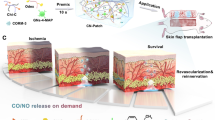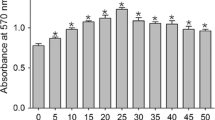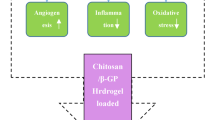Abstract
Basic fibroblast growth factor (bFGF) promotes epithelial cell proliferation and angiogenesis but its clinical applications are limited by its short half-life and low retention. Recently developed gelatin hydrogel sheets able to release physiologically active substances in a controlled manner have the potential to overcome these issues. In this study, the effects of gelatin hydrogel sheets impregnated with bFGF on flap survival and angiogenesis were examined in a murine skin flap model. A flap of 1 × 3 cm was generated on the backs of 60 C57BL/6 mice. The mice were divided into five groups (n = 12/group): Group I, untreated; Group II, treated with a gelatin hydrogel sheet impregnated with saline; Group III, treated with bFGF (50 µg) without sheets; Groups IV and V, treated with gelatin hydrogel sheets impregnated with 50 and 100 µg of bFGF, respectively. On the seventh day after surgery, the flap survival area and vascular network were examined and hematoxylin and eosin and von Willebrand factor staining were used for histological examinations. The flap survival areas were significantly larger in Groups IV and V than in other groups. The area of new vessels was significantly larger in Group IV than in the other groups. In the murine skin flap model, gelatin hydrogel sheets impregnated with bFGF promoted angiogenesis and improved flap survival. These findings support the use of bFGF-impregnated gelatin hydrogel sheets for improving ischemic flap survival in clinical settings.




Similar content being viewed by others
References
Uhl E, Barker JH, Bondar I, Galla TJ, Lehr HA, et al. Improvement of skin flap perfusion by subdermal injection of recombinant human basic fibroblast growth factor. Ann Plast Surg. 1994;32:361–5.
Kusumoto K, Isshiki N, Suzuki S, Ohtsuka M, Nose K. Increase in length of experimental skin flaps that survive with dibutyryl-cyclic-amp. Scand J Plast Reconstr Surg Hand Surg. 1995;29:111–6.
Gospodarowicz D, Ferrara N, Schweigerer L, Neufeld G. Structural characterization and biological functions of fibroblast growth factor. Endocr Rev. 1987;8:95–114.
Powers CJ, McLeskey SW, Wellstein A. Fibroblast growth factors, their receptors and signaling. Endocr Relat Cancer. 2000;7:165–97.
Kakudo N, Shimotsuma A, Kusumoto K. Fibroblast growth factor-2 stimulates adipogenic differentiation of human adipose-derived stem cells. Biochem Biophys Res Commun. 2007;359:239–44.
Kakudo N, Morimoto N, Ogawa T, Taketani S, Kusumoto K. FGF-2 combined with bilayer artificial dermis composed of collagen matrix prompts generation of fat pad in subcutis of mice. Med Mol Morphol. 2018;52:73–81.
Tabata Y, Nagano A, Ikada Y. Biodegradation of hydrogel carrier incorporating fibroblast growth factor. Tissue Eng. 1999;5:127–38.
Notodihardjo PV, Morimoto N, Kakudo N, Matsui M, Sakamoto M, et al. Gelatin hydrogel impregnated with platelet-rich plasma releasate promotes angiogenesis and wound healing in murine model. J Artif Organs. 2015;18:64–71.
Matsui M, Tabata Y. Enhanced angiogenesis by multiple release of platelet-rich plasma contents and basic fibroblast growth factor from gelatin hydrogels. Acta Biomater. 2012;8:1792–801.
Lu F, Mizuno H, Uysal CA, Cai XB, Ogawa R, et al. Improved viability of random pattern skin flaps through the use of adipose-derived stem cells. Plast Reconstr Surg. 2008;121:50–8.
Akimoto M, Takeda A, Matsushita O, Inoue J, Sakamoto K, et al. Effects of CBVEGF-A injection in rat flap models for improved survival. Plast Reconstr Surg. 2013;131:717–25.
Sheng L, Yang M, Li H, Du Z, Yang Y, et al. Transplantation of adipose stromal cells promotes neovascularization of random skin flaps. Tohoku J Exp Med. 2011;224:229–34.
Fujihara Y, Koyama H, Nishiyama N, Eguchi T, Takato T. Gene transfer of bFGF to recipient bed improves survival of ischemic skin flap. Br J Plast Surg. 2005;58:511–7.
Zacchigna S, Papa G, Antonini A, Novati F, Moimas S, et al. Improved survival of ischemic cutaneous and musculocutaneous flaps after vascular endothelial growth factor gene transfer using adeno-associated virus vectors. Am J Pathol. 2005;167:981–91.
Toutain CE, Brouchet L, Raymond-Letron I, Vicendo P, Berges H, et al. Prevention of skin flap necrosis by estradiol involves reperfusion of a protected vascular network. Circ Res. 2009;104:245–54.
Shalom A, Friedman T, Westreich M. The effect of postoperative aspirin on random pattern flaps in rats. Am Surg. 2007;73:1126–8.
Emery FM, Kodey TR, Bomberger RA, McGregor DB. The effect of nifedipine on skin-flap survival. Plast Reconstr Surg. 1990;85:61–3.
Iinuma T, Sawada Y. Topical application of capsaicin and flap survival. Br J Plast Surg. 1996;49:319–20.
Huemer GM, Wechselberger G, Otto-Schoeller A, Gurunluoglu R, Piza-Katzer H, et al. Improved dorsal random-pattern skin flap survival in rats with a topically applied combination of nonivamide and nicoboxil. Plast Reconstr Surg. 2003;111:1207–11.
Folkman J, Klagsbrun M. Angiogenic factors. Science. 1987;235:442–7.
Sun XT, Ding YT, Yan XG, Wu LY, Li Q, et al. Angiogenic synergistic effect of basic fibroblast growth factor and vascular endothelial growth factor in an in vitro quantitative microcarrier-based three-dimensional fibrin angiogenesis system. World J Gastroenterol. 2004;10:2524–8.
Edelman ER, Nugent MA, Karnovsky MJ. Perivascular and intravenous administration of basic fibroblast growth factor: vascular and solid organ deposition. Proc Natl Acad Sci USA. 1993;90:1513–7.
Yamamoto M, Ikada Y, Tabata Y. Controlled release of growth factors based on biodegradation of gelatin hydrogel. J Biomater Sci Polym Ed. 2001;12:77–88.
Kurita J, Miyamoto M, Ishii Y, Aoyama J, Takagi G, et al. Enhanced vascularization by controlled release of platelet-rich plasma impregnated in biodegradable gelatin hydrogel. Ann Thorac Surg. 2011;92:837–44.
Hosaka A, Koyama H, Kushibiki T, Tabata Y, Nishiyama N, et al. Gelatin hydrogel microspheres enable pinpoint delivery of basic fibroblast growth factor for the development of functional collateral vessels. Circulation. 2004;110:3322–8.
Hayashi K, Kubo T, Doi K, Tabata Y, Akagawa Y. Development of new drug delivery system for implant bone augmentation using a basic fibroblast growth factor-gelatin hydrogel complex. Dent Mater J. 2007;26:170–7.
Kimura A, Kabasawa Y, Tabata Y, Aoki K, Ohya K, et al. Gelatin hydrogel as a carrier of recombinant human fibroblast growth factor-2 during rat mandibular distraction. J Oral Maxillofac Surg. 2014;72:2015–31.
Kumagai M, Marui A, Tabata Y, Takeda T, Yamamoto M, et al. Safety and efficacy of sustained release of basic fibroblast growth factor using gelatin hydrogel in patients with critical limb ischemia. Heart Vessels. 2016;31:713–21.
Hato N, Nota J, Komobuchi H, Teraoka M, Yamada H, et al. Facial nerve decompression surgery using bFGF-impregnated biodegradable gelatin hydrogel in patients with bell palsy. Otolaryngol Head Neck Surg. 2012;146:641–6.
Fujihara Y, Koyama H, Ohba M, Tabata Y, Fujihara H, et al. Controlled delivery of bFGF to recipient bed enhances the vascularization and viability of an ischemic skin flap. Wound Repair Regen. 2008;16:125–31.
Tokunaga T, Ide J, Arimura H, Nakamura T, Uehara Y, et al. Local application of gelatin hydrogel sheets impregnated with platelet-derived growth factor BB promotes tendon-to-bone healing after rotator cuff repair in rats. Arthroscopy. 2015;31:1482–91.
Watanabe R, Hayashi R, Kimura Y, Tanaka Y, Kageyama T, et al. A novel gelatin hydrogel carrier sheet for corneal endothelial transplantation. Tissue Eng Part A. 2011;17:2213–9.
Haraguchi T, Okada K, Tabata Y, Maniwa Y, Hayashi Y, et al. Controlled release of basic fibroblast growth factor from gelatin hydrogel sheet improves structural and physiological properties of vein graft in rat. Arterioscler Thromb Vasc Biol. 2007;27:548–55.
Okumura M, Okuda T, Nakamura T, Yajima M. Acceleration of wound healing in diabetic mice by basic fibroblast growth factor. Biol Pharm Bull. 1996;19:530–5.
Author information
Authors and Affiliations
Contributions
Conceived and designed the experiments: MH, NK, and KK. Performed the experiments: MH, NK, and FL. Analyzed data: NM and TH. Contributed reagents/materials/analysis tools: JJ, and YT. Wrote the paper: MH, NK and KK.
Corresponding author
Ethics declarations
Conflict of interest
The authors report no proprietary or commercial interest in any of the products mentioned or any of the concepts discussed in this article.
Additional information
Publisher's Note
Springer Nature remains neutral with regard to jurisdictional claims in published maps and institutional affiliations.
Rights and permissions
About this article
Cite this article
Hihara, M., Kakudo, N., Morimoto, N. et al. Improved viability of murine skin flaps using a gelatin hydrogel sheet impregnated with bFGF. J Artif Organs 23, 348–357 (2020). https://doi.org/10.1007/s10047-020-01188-7
Received:
Accepted:
Published:
Issue Date:
DOI: https://doi.org/10.1007/s10047-020-01188-7




